You wouldn’t guess my samosa dough recipe can be mixed with 4 basic ingredients. It is so easy to make homemade samosa dough.

You probably already have the ingredients you’ll need in your pantry to make dough for homemade samosas, so let’s get started so you can get eating!
Table of Contents
- Why This Samosa Dough Is Easy And Foolproof
- Here’s What You Need To Make Samosa Dough
- How To Make Samosa Dough: An Easy Guide
- Make-Ahead Instructions
- Storage Instructions
- How To Use Samosa Dough
- 5 Common Mistakes When Making Samosa Dough
- Final Notes, Pro Tips + Science-Based Secrets
- Other Indian Recipes You’ll Love
- FAQs About Samosa Dough
- Easy Samosa Dough Recipe (only 4 ingredients!) Recipe
Why This Samosa Dough Is Easy And Foolproof
Here’s why this samosa dough recipe is failproof:
- Simple ingredients: The recipe uses basic ingredients like flour, water, salt, and oil, which are easy to find in most kitchens.
- Balanced ratios: The proportions of flour to water and other ingredients are well-balanced. This means the dough will come out with the right consistency for rolling and folding without being too dry or sticky.
- Resting time: The recipe includes a resting period for the dough. This means the gluten will relax, and the moisture will distribute evenly. The result is a pliable and workable dough and a flaky crust.
- Well Tested: I’ve made this dough batch after batch in making my favorite potato samosas and chicken samosas. Heck, I sometimes even fill them with ground beef taco filling (as pictured in the first photo).
The combination of simplicity, clarity, balance, and adaptability makes this samosa dough recipe highly reliable and failproof for home cooks of all levels.
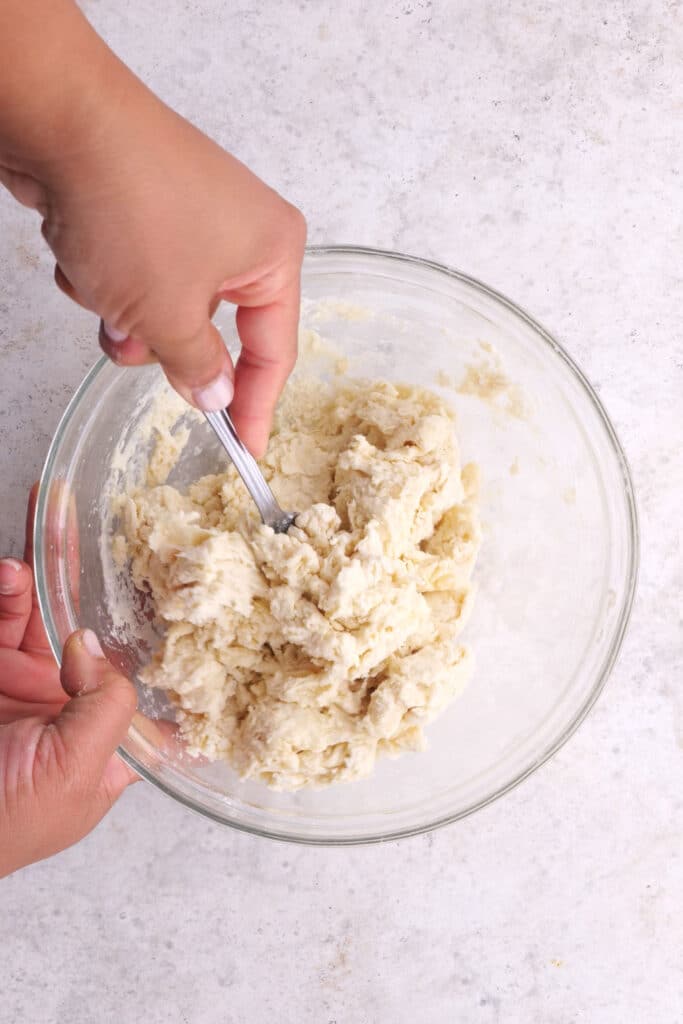
Here’s What You Need To Make Samosa Dough
Before we start, let’s go through the basic equipment and ingredients you need to make this easy samosa dough recipe.
Samosa Dough Ingredients
- Flour: You can use all-purpose flour for samosa dough.
- Salt: Just regular table salt is fine.
- Vegetable oil: Any neutral-tasting veggie oil will do.
Variations and Substitutions
You could add seasonings to your dough if you want to experiment. Here are a few ideas on what to add:
- Whole wheat flour: Substitute some all-purpose flour with whole wheat flour.
- Spices: Mix ground spices directly into the dough for extra flavor. Cumin powder or cumin seed, coriander seeds or powder, turmeric, and garam masala are great choices.
- Ajwain (Carom Seeds): Add a teaspoon of ajwain seeds to the dough.
- Chaat masala: Sprinkle it into the dough – I love its tanginess.
- Fenugreek leaves (kasuri methi): Crush some dried fenugreek leaves and mix them into the dough. These have an aniseed, slightly bitter taste. Fennel is a good alternative.
- Semolina (sooji): Mixing semolina with the flour can give the dough a nice crunch and texture.
- Ground, dried red or green chilies.
Grab these Tools
With everything ready, you’re all set to make a speedy batch of easy samosa dough:
- Mixing bowl: I recommend a medium to large size. Give yourself enough space to work comfortably with the dough.
- Wooden spoon: This is to mix everything. You could also use your hands.
- Plastic wrap/damp towel: I always make sure my dough is airtight when resting. This prevents dry skin from forming on the outside.
How To Make Samosa Dough: An Easy Guide
Moving on to how to make the dough, it will take a few minutes to mix it up. Then, all that’s left is to rest it until you’re ready to make samosas with it!
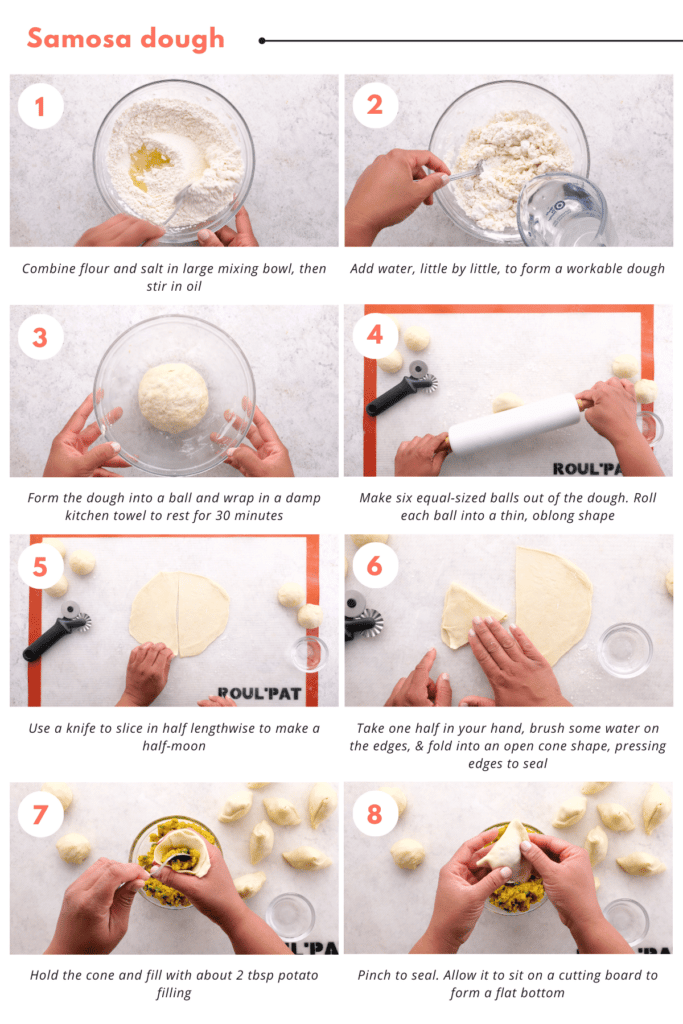
Mix the ingredients
-Start by adding the flour and salt to a large mixing bowl.
-Next, stir in the oil.
-Add water, a little at a time, to the dry mixture and mix to form a pliable dough.
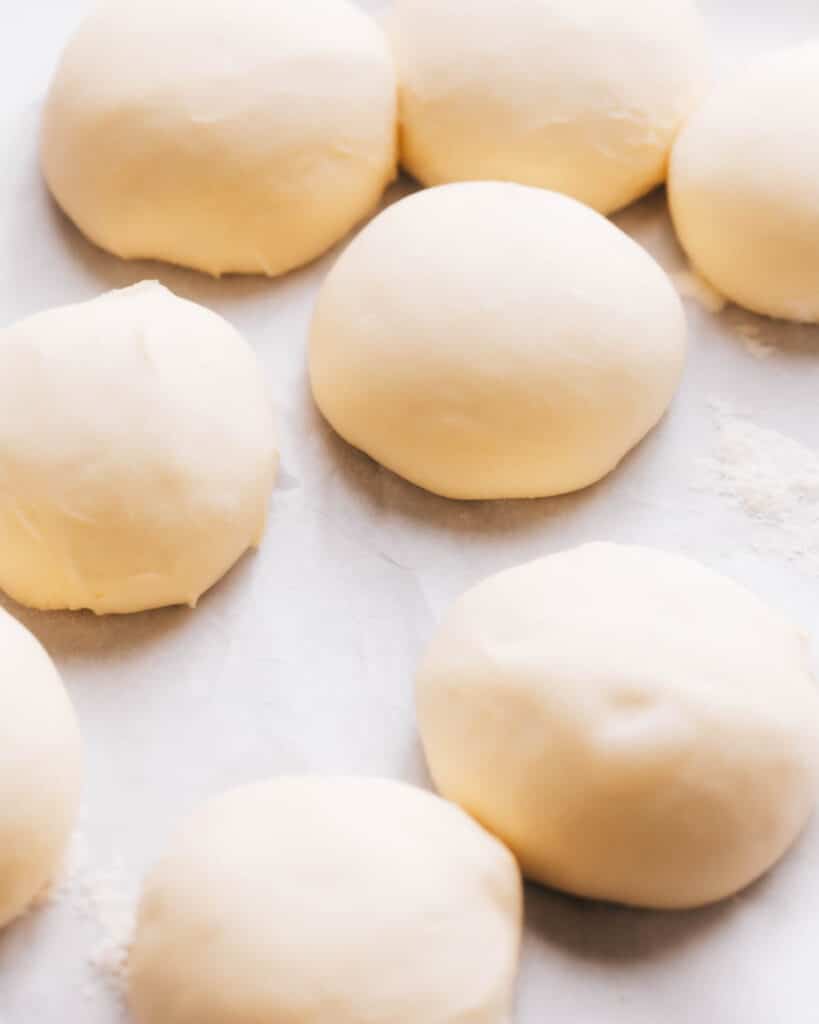
Rest the dough
-Roll the dough into a ball.
-Wrap tightly in plastic wrap or with a damp kitchen towel and rest it at room temperature for 30 minutes or so.
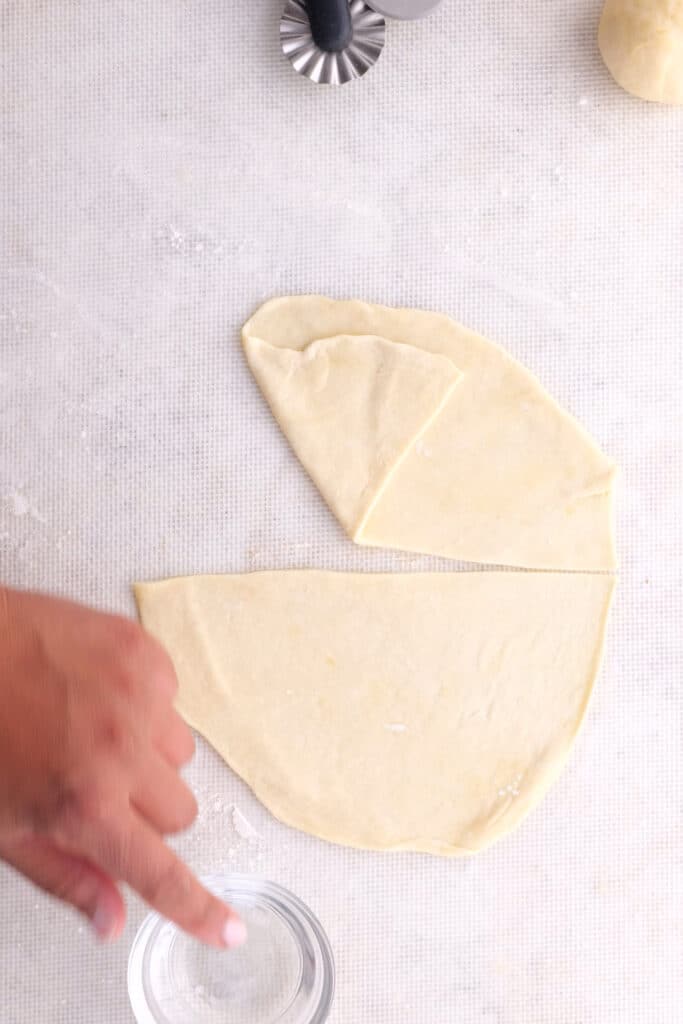
Fill and Fry
My potato samosas and chicken samosas have recipe-specific details on how to fill, shape and seal the dough, or you can follow the loose guideline in the step-by-step image above.
For frying samosas:
Fill a deep saucepan or Dutch oven with oil to a 3″ depth and warm it over medium heat. When the oil hits approximately 200ºF, start frying the samosas in batches.
Cook them for 15 minutes until they turn golden.
Then, ramp up the heat to high and continue frying for another 5 minutes until they achieve a deep golden brown color.
Use a slotted spoon to remove them from the oil and let them drain on paper towels.
Make-Ahead Instructions
- Prepare the dough: Follow the recipe, prepare and rest the dough.
- Refrigerate: Store the wrapped or containerized dough in the refrigerator for up to 24 hours before making samosas.
- Bring to room temperature: Before using the dough, let it sit at room temperature for about 15-20 mins. This allows the dough to soften slightly, making it easier to work with.
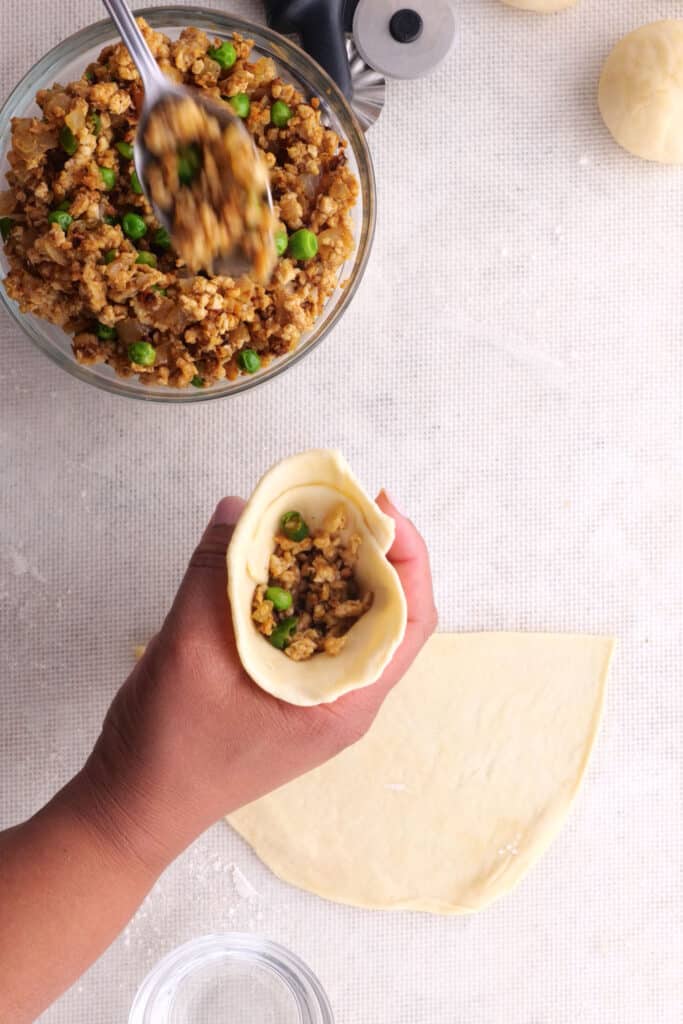
Storage Instructions
- Refrigeration: If I have leftover samosa dough, I wrap it tightly in plastic wrap or place it in an airtight container.
- Fridge storage: Store the wrapped or containerized dough in the refrigerator for 2-3 days. Make sure it is well sealed to prevent it from drying out.
- Freezing option: I like to freeze the dough for longer storage. Divide the dough into portions and wrap each portion tightly in plastic wrap. Store them in a freezer-safe bag or container.
- Thawing: When ready to use the frozen dough, transfer it to the refrigerator and let it thaw overnight. Then, let the dough sit at room temperature for about 15-20 minutes before rolling it out and shaping it for samosas.
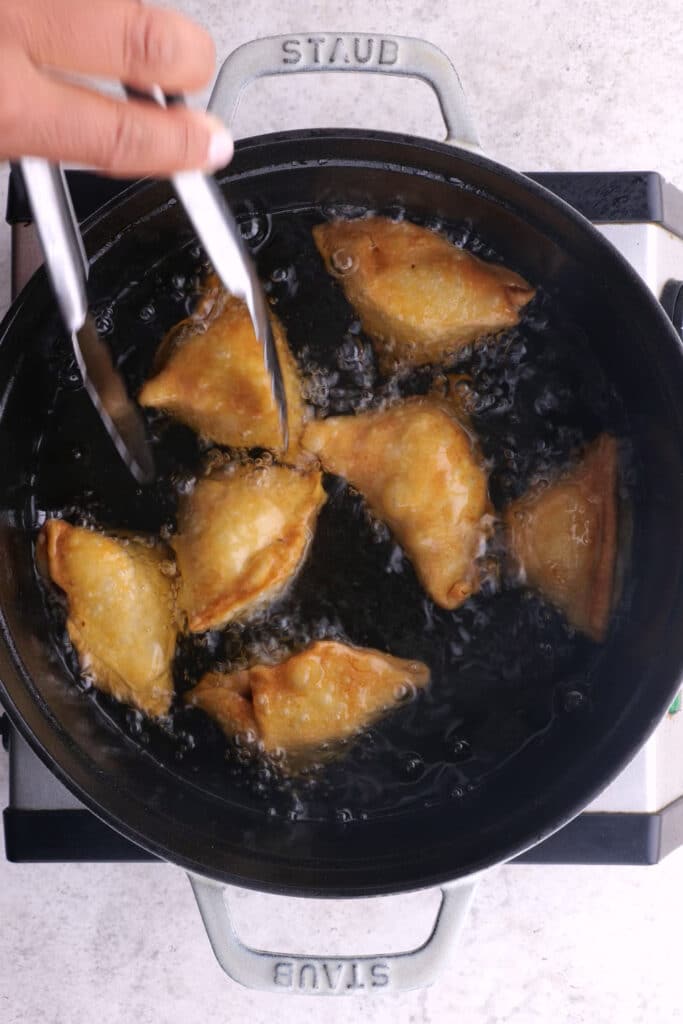
How To Use Samosa Dough
Of course, deep frying homemade samosas are the obvious way to use this dough.
Try my homemade potato samosa recipe. This recipe is loaded with incredible flavors like peas, potatoes, ginger, and spices. You’ve got to try them with a dip or green chutney!
Or, turn your dough into these chicken samosas! Get creative with other savory fillings made with beef, lamb, or other veggies.
Another delicious snack idea is to bake this pastry as a pie topping or make pastry pockets.
The dough is pretty flexible, so you can play around with it.
5 Common Mistakes When Making Samosa Dough
Here are five mistakes to avoid when making this dough:
- Incorrect consistency: If the dough is too dry, it will be challenging to roll out and may crack when folding. On the other hand, if the dough is too wet, it will be sticky and challenging to work with. My tip is to add the water slowly to get the dough texture just right.
- Overworking: Kneading the dough excessively can lead to tough samosa crusts.
- Skipping the resting time: Resting the dough relaxes the gluten, making it easier to roll out and shape.
- Using incorrect flour: Using the wrong type of flour can also affect the texture and consistency of the samosa dough.
- Not wrapping it properly: If the dough is exposed to air while resting, it will develop a dry outer crust. This will make it difficult to work with and affect the result. I suggest plastic wrap or damp paper towels.

Final Notes, Pro Tips + Science-Based Secrets
Here are a couple of other points to add to help get the perfect samosa dough:
- Rest is best: Resting the dough allows the gluten strands to relax, resulting in a more elastic and pliable dough that is easier to work with.
- Add water slowly. This allows you to adjust the dough’s texture as needed, resulting in a more manageable and workable dough for shaping and filling.
- Use a neutrally flavored oil: This way, the dough is mild in taste to carry the filling flavor.
Other Indian Recipes You’ll Love
Samosas are a firm favorite in our home (especially loved by my hubby, Adarsh). Here are a few of his other best Indian dishes for you to try:
- Creamy Madras Lentils (the ultimate vegetarian comfort food)
- Our family’s Best Butter Chicken and Chicken Korma recipes.
- Malai Kofta (paneer and potato balls in creamy tomato sauce). It’s my favorite dish to order in an Indian restaurant and even better homemade!
- Indian Chai (tea the authentic Indian way)
- Samosa Pie (I know you’re here because you love samosas! Put this one on your must-try list).
FAQs About Samosa Dough
Just skimming through? Here are a few things you might like to know:
All-purpose flour is typically used for samosa pastry. Some recipes include some chickpea flour (besan) for added flavor and texture.
Yes, you can substitute part or all of the all-purpose flour with whole wheat flour for a healthier version of samosa pastry. Note that whole wheat flour may yield a denser texture compared to using only all-purpose flour.
Resting the samosa dough allows the gluten to relax. This makes it easier to roll out and shape. It also helps to evenly distribute moisture throughout the dough, resulting in a better texture.
Resting the dough enhances its flavor and structure.
The samosa dough should be rolled out thinly, about 1/8 inch thick, to achieve a crisp and flaky pastry shell. Rolling it too thick may result in a doughy texture after frying.
Yes, you can prepare the samosa pastry ahead of time and freeze it for later use. After shaping the pastry, place it on a baking sheet lined with parchment paper. Make sure they do not touch each other, and freeze until firm.
Once frozen, transfer the pastry to a freezer bag and store it for up to a month. Thaw in the refrigerator before using.

Easy Samosa Dough Recipe (only 4 ingredients!)
Ingredients
- 1 ½ cups all-purpose flour
- ½ tsp salt
- 2 tbsp vegetable oil
- ¾ cup water
Instructions
- Combine flour and salt in large mixing bowl, then stir in oil.
- Add water, little by little, to form a workable dough.
- Form the dough into a ball and wrap in a damp kitchen towel to rest at room temperature for 30 minutes.
Video
Notes
- Add water slowly to manage the dough’s consistency.
- Knead the dough gently but don’t overwork it.
- Cover the dough while resting.
- Try not skimp on the total time you rest them for.
Nutrition
Nutrition information is automatically calculated, so should only be used as an approximation.



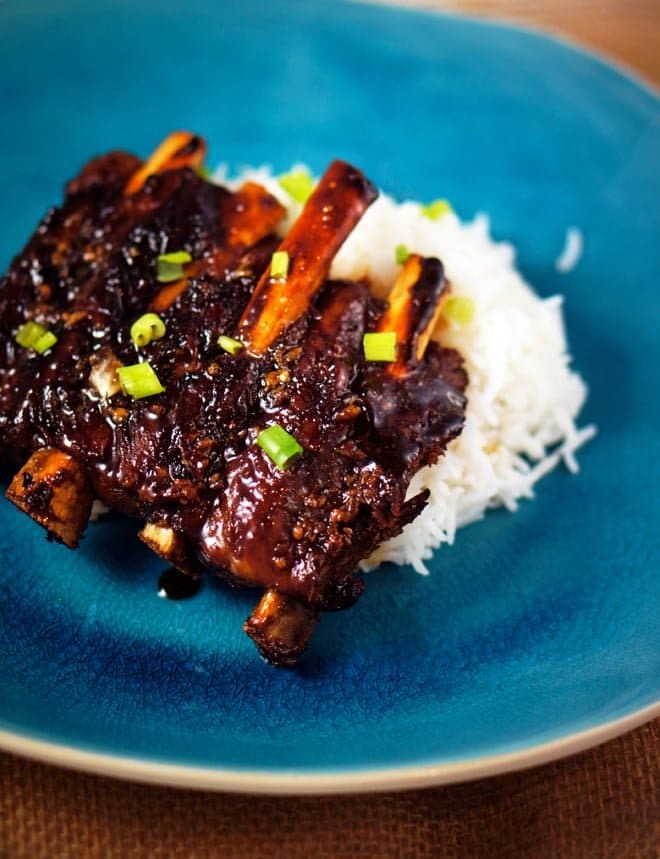










Great recipe! I love samosas, but making the dough always seemed intimidating. Thank you!